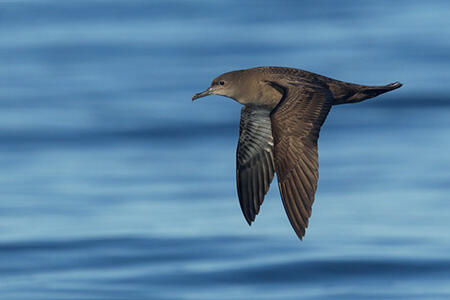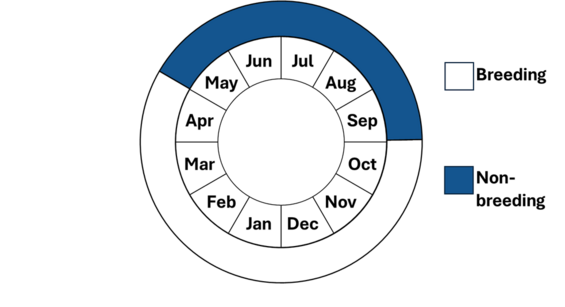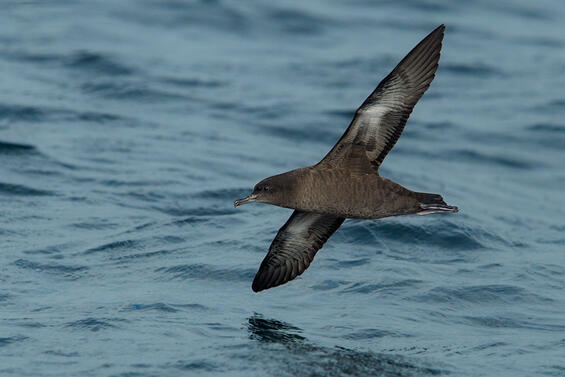- Scientific name: Puffinus griseus
Species of Greatest Conservation Need (MA State Wildlife Action Plan)
Description

Sooty shearwater (Puffinus griseus)
Sooty shearwaters are larger, dark shearwaters (40-51 cm [16-20 in] long, 650-978 g, wingspan 94-109 cm [37-43 in]). They are mostly brown to dark grey-brown with pale silver central underwings. They have a dark grey or brown bill and dull pinky-beige feet and legs. Shearwaters’ name comes from the flight pattern of gliding along the troughs of waves and “shearing” the water.
Life cycle and behavior

Sooty shearwaters nest in the south Pacific and Atlantic Oceans in southeast Australia, New Zealand, and Tierra del Fuego, in large, dense colonies amongst other Procellariiformes. Sooty shearwaters return to their breeding colonies beginning in late September. They are burrow nesters and can dig burrows up to 3 m (3.3 yards) long. Egg-laying begins in mid-November to early December following a roughly two-week pre-laying exodus. They lay a single egg that is incubated for 53-56 days. Both adults share incubation duties, staying anywhere from four to nine days at a time at the nest. Chicks are downy at hatch. Adults brood the chicks for several days and then alternate short (1-3 days) and long (5-15 days) foraging trips. Both adults provision chicks. Chicks fledge between 86-106 days. Sexual maturity is unknown but likely occurs around five to nine years. Immature individuals return to the colony prior to sexual maturity anywhere between two to ten years. Annual adult survival is high (93%).
Sooty shearwaters are transequatorial migrants and circumnavigate their respective oceans. Non-breeders will depart the breeding grounds first, followed by breeders in mid-April, and juveniles roughly a month later. Sooty shearwaters head en masse to the northwestern section of their ocean and move progressively east. They arrive to western North American and European coasts in late boreal summer and begin their southbound migration in August. Tracking studies confirm that breeding sooty shearwaters will cover 29,000 km (~18,000 mi) during their migration. Individual non-breeding sooty shearwaters in the Pacific completed a figure-of-eight that totaled 64,000 km (~40,000 mi).
The diet is varied, consisting largely of schooling fish (anchovies, capelin), cephalopods, and crustaceans. During the breeding season, diets are dominated by euphasiids and myctophids. Sooty shearwaters capture prey by pursuit-plunging, surface-seizing, hydroplaning, and diving. They dive from heights of three to five meters and typically reach 30-40 m (~100-130 ft) below the surface. Foraging sooty shearwaters are frequently associated with large numbers of other seabirds and cetaceans.
Population status
The global sooty shearwater population is estimated at 8,800,000 mature individuals. Although unconfirmed, it is suspected that the population is experiencing rapid decline. Several Pacific Ocean breeding colonies have confirmed or highly suspect breeding pair declines, and some mainland colonies are likely abandoned. A California Current population study in the 1990s estimated declines of up to 90% since the 1970s, although populations may have shifted spatially. Adding to the uncertainty, several Atlantic Ocean colonies have either unknown population estimates or are entirely unconfirmed.
Distribution and abundance
Sooty shearwaters are found throughout all major oceans (except the north Indian Ocean) and are abundant. In Massachusetts, sooty shearwaters are common to abundant and present offshore during the summer.
Habitat
Sooty shearwaters nest on densely vegetated slopes, usually on islands but also on mainland headlands. Sooty shearwaters nest close to coastlines but can be found inland as well. They can nest in high altitudes up to 1,500 km (930 mi).
At sea, sooty shearwaters are marine based. They are usually found in cold, offshore and pelagic waters, spending most their time over the continental shelf and slope.
Healthy habitats are vital for supporting native wildlife and plants. Explore habitats and learn about conservation and restoration in Massachusetts.

Sooty shearwater (Puffinus griseus)
Threats
Sooty shearwater declines are likely a result several factors that threaten their populations. Entanglement in fishing gear (longline, trawl, and gillnet) is common both at the breeding colony and on wintering grounds and considered to be a significant threat. Research indicates that climate change-related reductions in prey availability are reducing abundance and survival rates. Introduced rats are known to take eggs and chicks at the breeding colony, but the extent of this predation is unknown.
In New Zealand, around 13% (320,000 – 400,000) of sooty shearwaters chicks are harvested annually by Maori. Called “muttonbirding”, chicks are taken for food, soap, and oil and can be sold legally throughout the country. It is believed that the annual harvest does not impact overall population size.
Plastic trash in the environment poses a threat as it can be mistaken as food by seabirds and shorebirds and ingested or cause entanglement. Ingested plastics, common for seabirds, can block digestive tracts, cause internal injuries, disrupt the endocrine system, and lead to death. Entanglement from fishing gear and other string-like plastics can cause mortality by strangulation and impairing movements.
Conservation
Some key colonies, particularly in the south Pacific, are regularly monitored and receive protection. It is recommended to continue monitoring efforts range-wide, eradicate invasive predators, and produce updated population estimates. Further research is needed to address confirmed and possible threats, as well as identify key drivers in suspected population declines. Avoid or recycle single-use plastics and promote and participate in beach cleanup efforts.
References
BirdLife International. “Species factsheet: sooty shearwater Ardenna grisea.” 2019. https://datazone.birdlife.org/species/factsheet/sooty-shearwater-ardenna-grisea
Carboneras, C., F. Jutglar, and G. M. Kirwan. “sooty shearwater (Ardenna grisea), version 1.1. In Birds of the World” (J. del Hoyo, A. Elliott, J. Sargatal, D. A. Christie, E. de Juana, and F. Medrano, Editors). 2024. Cornell Lab of Ornithology, Ithaca, NY, USA. https://doi-org.silk.library.umass.edu/10.2173/bow.sooshe.01.1
Enticott, J., and D. Tipling. Seabirds of the World. Mechanicsburg, PA: Stackpole Books, 1997.
Mass Audubon. “State of the Birds: sooty shearwater Puffinus griseus.” 2025. https://www.massaudubon.org/our-work/birds-wildlife/bird-conservation-research/state-of-the-birds/find-a-bird?id=SOSH
Paleczny, M., E. Hammill, V. Karpouzi, and D. Pauly. “Population Trend of the World's Monitored Seabirds, 1950-2010.” PLoS ONE 10, no. 6 (2015).
Veit, R., and W.R. Petersen. Birds of Massachusetts. Lincoln, MA: Massachusetts Audubon Society, 1993.
Contact
| Date published: | May 15, 2025 |
|---|